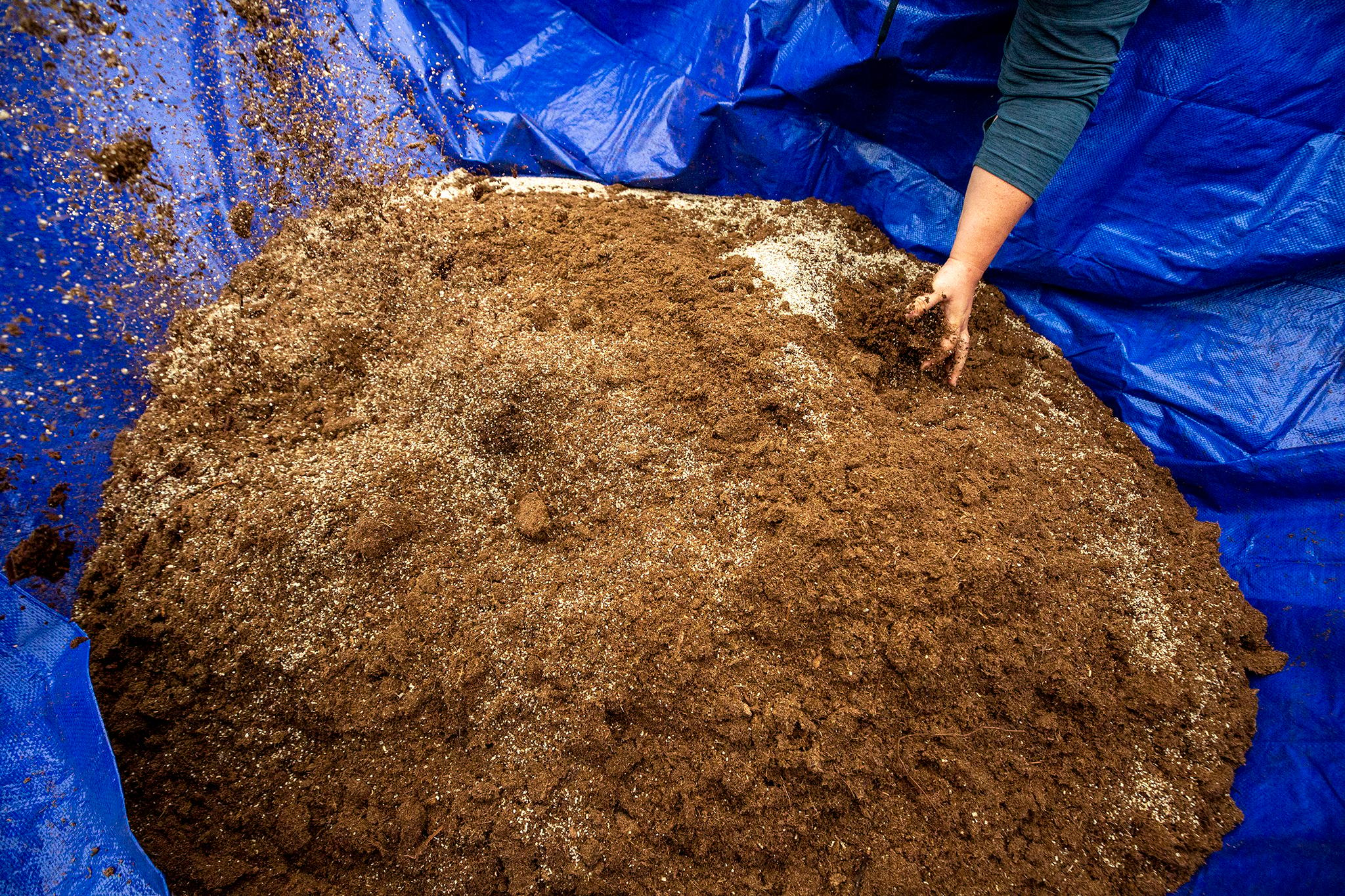Many hands and a big, blue tarp made a giant mixer.
Expert gardeners Gina Chilton and Clifton Parris were at the tiny home village in Globeville, working with a crew of residents on a weekend project. First, Chilton poured mounds of peat moss, compost and the soil conditioner vermiculite onto the tarp. Then the residents carefully lifted an edge of the tarp, sending the moss, compost and vermiculite cascading as if in a concrete mixer. The residents lifted the opposite edge of the tarp, then continued alternating until their three ingredients were thoroughly combined. Parris stepped in occasionally to stir with a shovel.
Then it was time to use the mixture to fill waist-high wooden planters that had been placed in front of five of the homes in the village, which is an alternative to shelter for people experiencing homelessness. Chilton and Parris started to direct the residents to drag the laden tarp to each planter. Deborah Clark, a village resident since February, didn't wait. She used a bucket to start taking the mixture to her planter on the northern edge of the village.

Once Clark's planter was filled and watered, Chilton advised Clark to place taller plants where they would not block the sun for others, and showed her how to make depressions with a finger in the moss-compost-vermiculite mix, sprinkle a few seeds in each shallow hole, then gently cover the seeds. Clark said she was eager to see "the green start coming out of the dirt."
Chilton said when she saw photos of the tiny homes, she knew her tiny gardens would fit perfectly next to each entrance.

Chilton connected with Dorothy Leyba, a village organizer for the Colorado Village Collaborative, which sponsors the Globeville village. Chilton had read that Globeville was a food desert and thought the Square Foot Gardening method, which she teaches at garden clubs and private homes, could help improve food security for village residents. Parris said Square Foot Gardening can produce two to three pounds of lettuce or spinach, eight to 10 pounds of tomatoes or green beans and more in plots the size of those placed in the village, with minimal care and watering.
Leyba said that thanks to pantries and other resources, hunger was not a problem at the village. But she and and fellow organizer Hannah Fageeh saw other needs they thought gardening could fill.

Village residents are among the many people across the country who have lost jobs because of the pandemic. One village resident who was going to college was no longer able to go to campus. Outings to the library that had been a favorite activity of many residents were no longer possible because of coronavirus closures. Leyba and Fageeh were becoming concerned that isolation and loss of routine were having a negative impact on residents' mental health.
Leyba saw gardening as an opportunity for "using your hands and learning something new."
"It's nurturing," Leyba said. "What's exciting too is that it's healthy. We're really trying to foster a healthy community."
Fageeh added: "It's really empowering to be able to grow your own food."
Village residents are encouraged to work together to solve any problems. During the coronavirus outbreak, that has meant taking such steps as setting aside some of the shared bathrooms for residents who are most vulnerable to COVID-19. (The village has had no coronavirus cases.)
Nurseries around Denver were crowded early in the pandemic as people turned to gardening as a stress-reliever. Leyba and Fageeh had encouraged gardening in the spring at the Beloved Community Village, but found interest was not high. By the time Chilton called a few months ago, some of the village's 16 residents were more ready to embrace the idea.

Chilton and Parris donated the five raised beds they brought to the village on Saturday, as well as seeds, watering buckets and other equipment. The seeds were for such late-season crops as spinach, turnips and carrots and beets.
"Most of these can handle a little bit of frost. And the beets get sweeter," Chilton said during a briefing on the porch of the village's community center before the beds were prepared and seeds planted.
During the briefing, Fageeh brought out seeds that had been donated earlier. Chilton sorted through them with the village residents to determine which could be planted now.
"Cantaloupe?" Aurora Babcock asked.
"Not until spring," Chilton answered.
Babcock carried her garden-on-stilts to a tiny home she has decorated with swirls of paint in blues and purples. She said she planned to grow flowers as well as vegetables, but wasn't confident in her gardening skills.

"My intention is to try," Babcock said. "Whoever gets this house after me, I would hope they would keep it (the garden) up."
In the three years since the Beloved Community Village was founded, 10 of the 31 people it has served have moved on to stable housing, said Cole Chandler, executive director of the Colorado Village Collaborative. Chandler added that one of those now housed recently moved into the Walnut Street Lofts, an income-restricted complex built by the Urban Land Conservancy, an affordable housing developer, on a plot where Beloved Community Village once stood near the 38th and Blake commuter rail station. The village moved to 4400 N. Pearl St. in Globeville when the Urban Land Conservancy was ready to build.
"That's the kind of arc that we're looking to create on the land that we utilize," Chandler said.
A second Colorado Village Collaborative tiny home village, for women and transgender individuals, is under construction on a block in the Cole neighborhood bounded by York and Gaylord streets and 37th and 38th avenues.
Eventually, like the 38th and Blake site, the block will be home to permanent affordable housing. Mile High Ministries, which for decades has provided transitional housing and other community services in Denver, plans to build 61 income-restricted apartments on the block. Affordable housing developer Habitat for Humanity plans to build 17 for-sale town homes on the site as well. Chandler said he hopes village residents would one day move into the permanent housing at the site.
"There's been lots of learning and growing," Chandler said.















